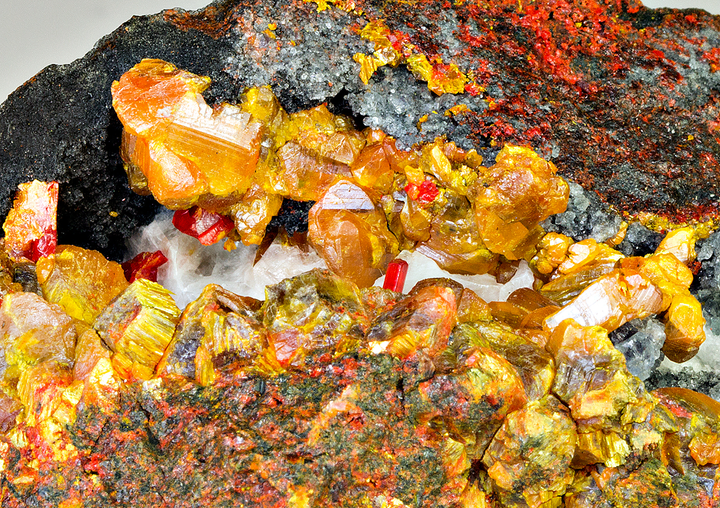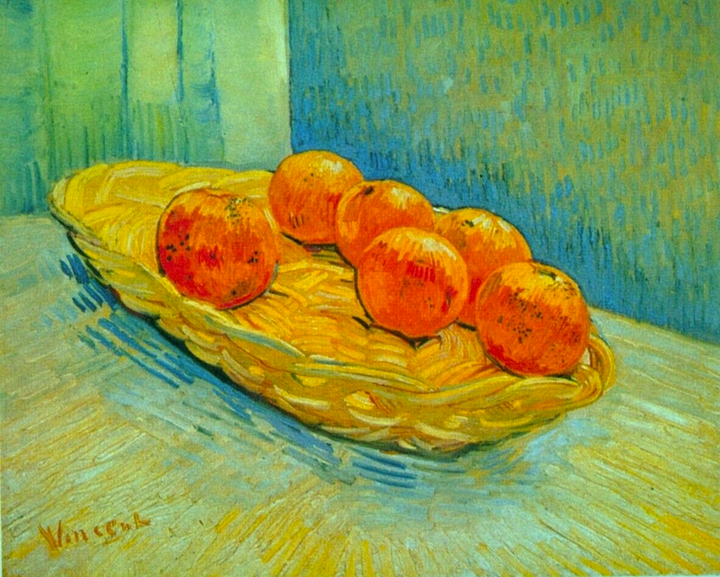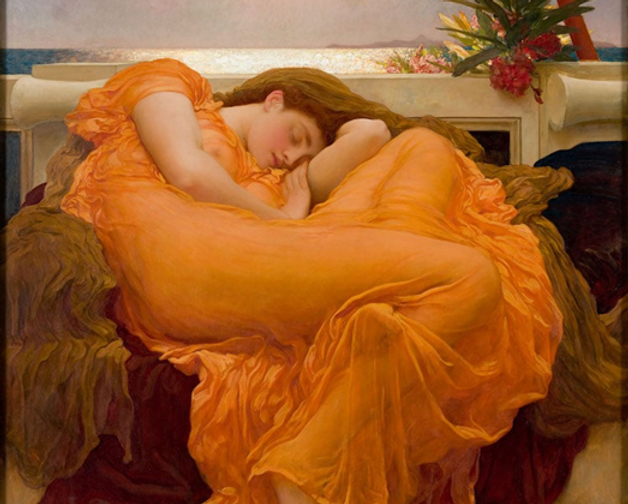The colour orange has a complex, sometimes even confusing, history that can often be overlooked. Its presence in humanity’s artistic record is believed to first appear in the ruins of Ancient Egyptian tombs. Tomb walls were often covered with images of gods and historical figures in which a mix of yellow, orange and brown were used to depict a wide variety of individuals.
They created orange pigments by crushing, washing and sieving a reddish-orange mineral known today as realgar, a highly toxic substance that contains arsenic and has a tendency to decay when exposed to air. This creates a faint yellowish tinge over the darker pigment it usually creates and was used in its natural and artificial forms until the 19th century.
Thousands of years after the first civilisations in Ancient Egypt, the main ingredients used to produce orange pigments were a profitable trade product in Ancient Roman society. One of the by products of decaying realgar is a deep golden crystal called orpiment. Ancient Romans used this to create vivid pale orange and yellow dye for cloth, as well as in their paintings. Orpiment also became a key ingredient in traditional Chinese medicine, even though it is equally as toxic as realgar.

This toxicity has also resulted in orpiment’s presence in fly poison and on arrowheads. Romans also used cinnabar, a mineral containing both mercury and sulphur, to create orange pigments. Meanwhile, orange was developing a spiritual role in the ancient Eastern world that still retains its power today. The word for ‘orange’ in Indian and Chinese languages tends to derive from the word for ‘saffron’, a plant-based spice and dye that is still used today, that produces a vibrant orange or yellow shade. Hindus associate orange with fire and therefore with piety and purity. Fire has the unique power of burning away impurities, representing religious dedication as well as the quest for good karma.
It is also a representative colour for Rajputs, members of the warrior caste in the Hindu caste system. The colour also has a spiritual role in Buddhism, as a symbol of truth and illumination. The Buddha taught that orange represents the ‘flame of truth’, which helps to lead to enlightenment. As part of this, Buddhist monks wear orange robes to remind themselves of their dedication to the quest for enlightenment and to represent the light of the sun. Orange has a slightly different part to play in the ancient Chinese philosophy known as Confucianism. It was founded by Kong Fuzi (often latinised as Confucius) in the 6th century BCE and heavily influenced the development of modern Chinese values of honour, hard work and respect. Confucianism helps individuals define the roles that people play in each other’s live and encourages social order and cohesion, as well as kindness towards all.

Under this school of thought, orange is the colour of transformation. The English word ‘orange’ is believed to come from the Spanish word ‘naranja’, which has its own roots in the Sanskrit ‘nārānga’. Both words refer specifically to the orange fruit, not the colour. The first uses of ‘orange’ as a colour-based adjective appear in the 16th century CE. With that in mind, it’s highly likely that the colour we know today as ‘orange’ was named after the fruit.
Before the 16th century, orange was just ‘yellow-red’: a mix of pre-existing colours. By the time of the Impressionist art movement in the 1860s, the importance of orange in realistic art was beginning to be recognised by European artists. Orange is the complementary colour of blue and during this period it allowed artists to explore more complex landscape scenes and develop greater contrast.
Vincent Van Gogh is one of the most well-known artists of this movement, and he arguably used the colour to his advantage more than most. The wave of enthusiasm for orange was only added to after the invention of chrome orange – made from a mineral form of lead chromate. It was safer to use and far more reliable than realgar. It only stopped being used properly in the late 20th and early 21st centuries: today, synthetic pigments are more commonly used.

Orange is also closely linked to civil unrest. The Orange Order of Ireland is an international organisation that pushes for Protestant values in Ireland. It was originally founded in the late 18th century to protect and assist the rise of Protestantism in Ireland. The Orange Order itself was named after William of Orange, the Dutch king that replaced the Catholic James II to become William III of Ireland.
Even today, in Northern Ireland, William’s ascension to kingship is celebrated by Protestants. On the 12th of July each year, they organise parties and parades that focus on and feature the colour orange. This tradition to parade and celebrate William’s rule has led to unrest in other countries, however. The Orange Riots of 1870 and 1871 in New York City occurred when Protestant participants taunted Catholic individuals they met along the parade route. These Catholics then followed and heckled the parades. This eventually led to riots between the two sides, and authorities had to intervene, however not before at least eight people lost their lives. The following year, attempts were made to stop the parade from taking place at all, eventually, though, pressure from the Orange Order and the city’s elite resulted in t he approval of the parades: with heavy protection from the city’s police and militia. Despite those precautions, violence once again broke out, and many people were wounded and even killed. The next day, around 20,000 mourners paid their respects to the dead. But Ireland’s Orange Order is not the only time that orange has been associated with unrest.
In late 2004, the Orange Revolution saw Ukrainians peacefully protesting against the rise of Viktor Yanukovych, a politician supported by the Kremlin and successfully prevented him from becoming president in Ukraine. That Revolution later opened the doors for a less controlled press, even though Yanukovych later won the presidency in 2010. His efforts to regain control of the press led to his downfall in 2014.
Today, in the Western world, orange is the colour of autumn and sunsets. But it’s also widely used in safety equipment, given it’s a bright shade that stands out against its surroundings. This is especially true of life jackets and life rafts, allowing them to stand out against the blue of the ocean. Orange is also closely associated with positivity, creativity and enthusiasm.

The influences of both red and yellow are clear in the symbolism given to the colour orange: it’s cheerful like yellow, but more muted by the red.





















